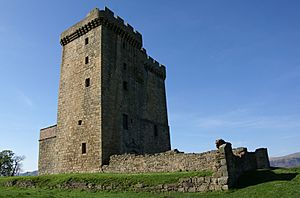Clackmannan Tower facts for kids
Clackmannan Tower is an old, tall building with five floors. It's located on top of King's Seat Hill in a place called Clackmannan, Clackmannanshire, Scotland. This tower has been around for a very long time, since at least the 1300s!
It was once home to King David II of Scotland. In 1359, King David sold the tower to his cousin, Robert Bruce. Today, Clackmannan Tower is a special protected site, known as a scheduled ancient monument.
What Does Clackmannan Tower Look Like?
Clackmannan Tower sits on King's Seat Hill, right on the edge of Clackmannan town. It's about 55 meters (180 feet) above sea level. From the tower, you can see the River Forth to the south. To the north, you can spot the beautiful Ochil Hills.
The tower still looks much like it did in medieval times. The roof is still there, which is amazing for such an old building! Part of the eastern wall had to be rebuilt in 1950 after it collapsed.
The building has an L-shape and five floors. The oldest part of the tower is on the north side. A slightly taller section was added around the 1500s on the south side. This newer part is made of pink sandstone blocks. It even has a fireplace on the second floor, which was common for buildings from that time.
South of the tower, you can find gardens. There's also an area that might have been used for bowling long ago. On the northern side, there's a large flat area or platform.
The History of Clackmannan Tower
The land where Clackmannan Tower stands originally belonged to the Scottish Crown. In the late 1100s, the town of Clackmannan had a mill. This mill belonged to the monks of Cambuskenneth Abbey.
We don't know exactly when the first tower was built. Some local stories say that Robert the Bruce built it. King David II of Scotland was living in the town in 1329. So, the tower might have been built by then.
In 1359, King David sold the site to his cousin, Sir Robert Bruce. The sale included a hunting lodge. King David probably wanted to keep the property in the Bruce family.
Around the year 1500, the south wing was added to the tower. Later, in the 1600s, a moat (a ditch filled with water) and a drawbridge were built. Walls were also constructed around the tower for protection.


